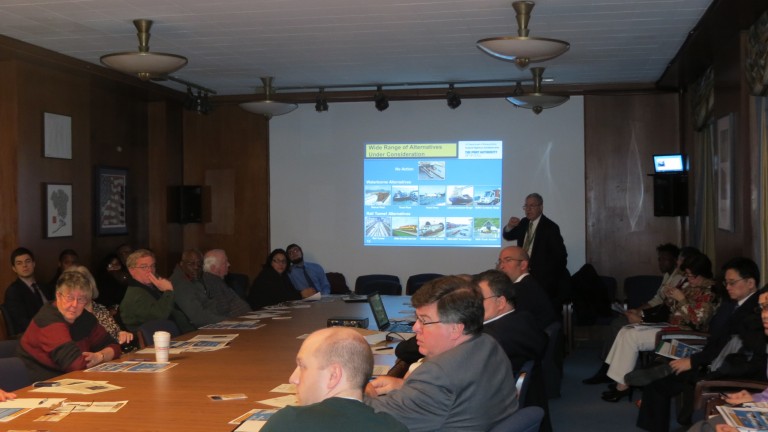PHOTO: Port Authority officials met with the Queens Borough Board in January to detail Cross Harbor Freight Program options. Forum Photo by Michael V. Cusenza
The Final Tier 1 Environmental Impact Statement for the Cross Harbor Freight Program is now available for download and review, the Port Authority of New York and New Jersey recently announced.
Produced by the U.S. Department of Transportation, Federal Highway Administration, and the Port Authority, in cooperation with the Federal Railroad Administration, Federal Transit Administration, U.S. Army Corps of Engineers, U.S. Environmental Protection Agency, Advisory Council on Historic Preservation, New York State Department of Transportation (Regions 10 and 11), New York State Office of Parks, Recreation & Historic Preservation, New York City Department of City Planning, and the New York City Department of Transportation, the Tier 1 EIS examines the potential transportation and environmental effects from a broad range of alternatives for the CHFP.
The primary purpose of the CHFP, according to the Port Authority and FHA, is to improve the movement of freight across New York Harbor between the east-of-Hudson and west-of-Hudson regions. By improving the movement of goods across the harbor, the CHFP would provide near-term and long-term improvements to the regional freight network, reduce truck traffic congestion, improve air quality, and provide economic benefits.
“We need to move goods more efficiently,” the Port Authority has said of the CHFP. “The region needs non-highway alternative freight movement options to increase reliability and resiliency, while reducing costs.”
Ten build alternatives have been selected for evaluation of benefits and potential environmental effects in the Environmental Impact Statement: five waterborne and five rail tunnel alternatives. The four project goals are: reduce the contribution of cross-harbor truck trips to congestion along the region’s major freight corridors relative to No Action conditions; provide cross-harbor freight shippers, receivers, and carriers with additional, attractive modal options to existing interstate trucking services; expand facilities for cross-harbor goods movement to enhance system resiliency, safety and security, and infrastructure protection; and support development of integrated freight transportation/land use strategies.
The goal of the Tier I study is, according to the EIS, “to select the altematives for further study and potential implementation, with a focus on freight transportation modes, alignment, logical termini, and regional effects. The potential environmental effects are identified and evaluated to the extent feasible without detailed engineering design and operational plans. The ElS also identifies geographic and technical areas where further study would be needed to assess environmental effects and/or mitigate potential significant adverse impacts.”
According to the Port Authority, “If we don’t take action, today’s traffic-jams will get worse, and extend for longer and longer periods beyond typical commuting hours. Projected growth in demand for goods—combined with continued dependence on trucks traveling overburdened roads—will create even more congestion, environmental challenges, and safety concerns. It’s not just your time at risk—our region’s overwhelming dependence on trucking for freight movement increases the costs and environmental impacts of goods movement, while decreasing the reliability and speed of freight delivery and diminishing the safety of our roadways and infrastructure. With expected future growth in freight movement, truck vehicle miles traveled will increase and so will the inefficiencies and adverse effects of our dependence on trucks for freight movement, including higher transportation costs, which would be passed on to consumers as higher prices for goods.”
By Michael V. Cusenza
michael@theforumnewsgroup.com

